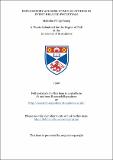Files in this item
Exploratory accross-stimulus studies in event-related potentials
Item metadata
| dc.contributor.advisor | Rugg, M. D. (Michael D.) | |
| dc.contributor.author | Young, Malcolm Philip | |
| dc.coverage.spatial | 427 p. | en_US |
| dc.date.accessioned | 2018-06-29T09:59:17Z | |
| dc.date.available | 2018-06-29T09:59:17Z | |
| dc.date.issued | 1990 | |
| dc.identifier.uri | https://hdl.handle.net/10023/14740 | |
| dc.description.abstract | Event-related potentials (ERPs) were evoked by visually presented words in a number of experimental paradigms. The question of which linguistic factors, if any, underlie differences between visual word ERPs was addressed. These studies identified 3 factors as predictors of ERF variance. Studies of ERPs in language processing tasks are selectively reviewed, and methodological problems associated with ERPs evoked by non-identical stimuli are discussed. The importance of an understanding of the linguistic factors which underlie ERP differences is outlined, and a methodology for approaching this issue is set out. The statistical procedure necessary to address the question is developed and described in Chapter Two. This procedure was a quantitative modelling strategy, based on multidimensional scaling and PROCRUSTES rotation. Five quantitative modelling studies were undertaken. These experiments involved two experimental tasks, a passive exposure task in which the subjects attended but did not respond to the stimuli (experiment 1) and a category membership decision task (experiments 2 to 5). Words drawn from two semantic categories were employed. ERPs were evoked by individual members of the category of colour names (experiments 1 to 3) and by members of the category of furniture terms (experiments 4 and 5). The results of these studies suggested that word length was the important factor in the early part of the post-stimulus epoch and that this factor was followed by semantic similarity. A late positivity was present in the decision task ERPs whose modulation was related to word frequency. These results were validated by two conventionally analysed experiments which examined the relation between word length and repetition and that between word frequency and repetition. It is concluded that three factors underlie ERP variance in the experimental paradigms employed. These factors are word length (physical extent was not dissociated from length in letters), word frequency and semantic similarity. These results may inform issues of experimental control in future studies of ERPs and language processing, may suggest some reassessment of existing studies in which control was not effected for these factors and may have provided a method of wider utility in cognitive neuroscience. The results suggest that systematic information can be derived about the linguistic characteristics of individual words from single word ERPs. | en_US |
| dc.language.iso | en | en_US |
| dc.publisher | University of St Andrews | |
| dc.subject.lcc | QP376.5Y7 | |
| dc.subject.lcsh | Electroencephalography | en |
| dc.title | Exploratory accross-stimulus studies in event-related potentials | en_US |
| dc.type | Thesis | en_US |
| dc.contributor.sponsor | Biotechnology and Biological Sciences Research Council (BBSRC) | en_US |
| dc.type.qualificationlevel | Doctoral | en_US |
| dc.type.qualificationname | PhD Doctor of Philosophy | en_US |
| dc.publisher.institution | The University of St Andrews | en_US |
This item appears in the following Collection(s)
Items in the St Andrews Research Repository are protected by copyright, with all rights reserved, unless otherwise indicated.

